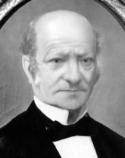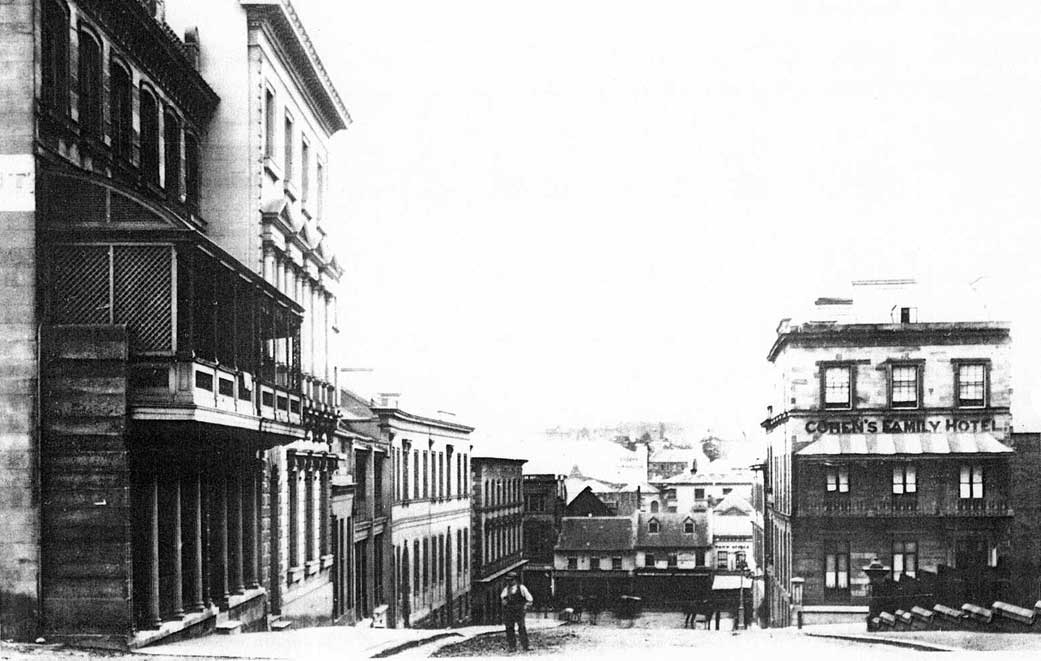Cohen
Beginnings in Australia
Henry Cohen: From clothier to convict to merchant

Above: Henry Cohen 1790-1867. Opposite: The Elizabeth Cohen, eventually acquired by Henry Cohen and family, which carried goods and passengers between Sydney and Port Macquarie. |
|
The story of the Cohen family in Australia which is
one focus of this site can conveniently be commenced around two Jewish convicts.
The first was Henry Cohen, a "merchant
taylor" (running a new and used clothing shop)
from London, who at the age of 43 was convicted at the Old Bailey in that
he "on
the 20th of March, did receive and have of a certain evil-disposed person,
2 promissory notes... each, the property of our sovereign Lord the King,
which had been lately before stolen, he well knowing them to have been stolen
against the statute." For
this on 26 August 1833 he was transported on the Lloyd to Australia for a
sentence of 14 years. The second was James
Simmons,
convicted for jewel theft from no less a personage than the Dowager Marchioness
of Devonshire. For this he received the death sentence, but it was subsequently
commuted to penal servitude in Australia and he was transported in 1815.
It is clear the families had already become acquainted
in London. But in any case the two convicts - Henry Cohen and James Simmons
- become connected by marriage. Sometime around 1808 Henry, still in London,
meets a girl by the name of Elizabeth Simmons -
the sister of James Simmons - and
marries her in 1809. Their first daughter is Nancy,
born in 1812. After Henry's conviction Nancy marries Joseph
Simmons who is the brother of James Simmons. Joseph has travelled to
become a free settler in Australia and then returned to London and married
Nancy there. He then after Henry's conviction he returns to Australia on
the ship The
Brothers,
accompanying Elizabeth, Nancy and the rest of Henry's family. And so the
families of the two convicts are twice joined and closely intertwined.
The story of the two families have much in common. Both convicts would be joined by family members as free settlers who would manage to make their lives comparatively easy and productive whilst they served their time. Once granted their tickets of leave, both convicts would then go on to establish themselves in the new colony as wealthy merchants. Henry becomes a merchant, store owner and ship owner. James becomes a publican, auctioneer and eventually the owner of a well stocked Sydney store.
There are of course more than one story that can be told around families marrying and intermarrying in a complex world disrupted by emigration both forced and voluntary. Indeed another interconnection has been mentioned already - the marriage between another daughter of Henry - Sophia Cohen and another free settler, Abraham Cohen, the descendant of Don Menachem Chajim Ha-Kohen of Schwienfurt. So there will be no attempt here to tell "the" story of the Cohen family. Rather it will be sufficient to make a few observations about the descendants of Henry whilst drawing attention to other much more substantial accounts and other relevant resources available on this site.
In particular:
- Much detail of the story of Henry Cohen and his descendants is well researched and described by Philip Cohen. His account Henry Cohen: 1790-1867 is reproduced with permission here.
- Another contribution, in the form of a book by Barbara Falk, No Other Home: An Anglo-Jewish Story 1833-1987 (Melbourne, Penguin: 1988) provides a more academically developed account of the dynamics by which Henry Cohen as a Jewish ex-convict ,and his descendants, would sufficiently integrate themselves into the Melbourne community to become over several generations prominent figures in the society. This book, again with the kind permission of the author and the publisher, Peguin Books Australia is reproduced in scanned form here.
So much of what follows is drawn, sometimes verbatim, from these two sources (and in particular that of Philip Cohen) that footnotes to these works on most occasions will be omitted. What follows should be regarded as a precis of them. The slant taken, however, is of course the sole responsibility of the site author.
In addition to the two important accounts above it is possible to read here the transcript of trial of Henry Cohen and judge whether, on the evidence, he should have been convicted.
Family mythology indeed has it that he was wrongfully convicted, and certainly in his trial he complained of his inability to call witnesses at his appearance before the magistrate where he was committed for trial. But be that as it may, it was not the first time he had been found with stolen promissory notes, and found guilty at the Old Bailey, and sentenced to transportation for 14 years. And so, Henry Cohen, Convict, indent 104, "blue eyed, ruddy complexion, brown hair and bald, breast hairy, scar on ball of left thumb, scar on back of same, wife Elizabeth Cohen, Son-in-Law Joseph Simmons, remainder of family to arrive per Brothers", arrived on the Lloyds 18th December 1833.
Some Colonial Correspondence surrounding his entry into and time as a convict in Australia have been reproduced here. These include those relating to the determination that he had skills useful to the colony and as a consequence his designation as a "special", subsequent maneuvers by his family to further disentangle him from the constraints of penal servitude by attaching him to one or other of the family, and his eventual conditional pardon.
Much of the success of Henry, his family and descendants needs to be understood in the context of Henry's wealth prior to his conviction. In June 1821 Henry was described as a Salesman. Later that year, in October 1821, he moved to 91 Edgeware Road, Paddington and three years later is on record as a Clothes salesman (and later Tailor) of 111 Edgeware Road, Paddington, Middlesex. By the year of his conviction (1833) Henry had a large new and used clothing shop premises at 126 Edgeware Road. He also had a large family with ten children: four girls and six boys. At his trial Henry claimed that his business returned him £4000 to £5000 per year. And when he was detained at Bow Street Police Station he had on his person—in addition to the stolen bank promissory notes—a £100 bank note and some sovereigns. As Philip Cohen points out, this was at a time when a tradesman earned about £5 per week, an unskilled worker about £3 per week, and a domestic servant about £2 per week plus board.
It was thus possible for Henry's family not only to follow his less than glorious forced exodus to Australia in a more dignified way aboard the Brothers but also to set themselves up as a free settler family of some wealth. Correspondence from the Principal Superintendent of Convicts, Frederick Augustus Healy, to the Colonial Secretary on 8 January 1834 confirms that:
The Convict Henry Cohen, Lloyds, who was named in the muster list of the ship as a Tailor, and as such applicated [sic] to the mounted police, turns out to have been a Merchant Tailor, and knows nothing of the trade, and he has been accordingly returned by Capt. Williams to the Convict B[arracks]. On seeing this man this morning, and learning somewhat of his history, I find he is one of that class of convicts called “special” but as my impression on this subject may be erroneous I forward him herewith for your inspecture [sic] and for the Commands of His Excellency the Governor, as to his disposal. This man is a Jew, and was tried for having stolen Bank notes, and I am informed his family have brought a large sum to the colony by the Brothers.
Henry himself was of course well educated, an entrepreneurial businessman, and therefore useful to whoever might obtain his services and with a family of sufficient means to encourage an arrangement of mutual benefit. When the Colonial administration saw through the various attempts to attach Henry directly to the family he was sent to Port Macquarie which had been established in 1821 as a place of secondary punishment.

Looking west down Clarence Street, Port Macquarie, c.1870.
On 17 January 1834 Henry was assigned on request as a domestic servant of Major Archibald Clunes Innes. His duties are not known but, given his skills, were unlikely to have been those of a domestic servant. Nor do we know what else may have transacted between his family and the good Major. Nevertheless Philip Cohen cites evidence that whilst the Major lived on his property at Lake Innes, which was six miles from the township, Henry was living with his family in the township of Port Macquarie. Subsequent attempts to have him reassigned to James Simmons (who had by then a conditional pardon) were not successful. But on 14 February 1840 Henry was granted his Ticket of Leave and now was now able to take control of his assets in his own name, at least in Port Macquarie.
Those assets were by now considerable. “The Cohen family became well known traders in the district, with a store in Horton Street (now the Commonwealth Bank building), and their own vessel, the Elizabeth Cohen, which carried goods and passengers between Sydney and Port Macquarie.” Indeed, the Elizabeth Cohen was not the only vessel owned by Henry. He owned also, for example, a steamship - Thistle - whose sister ship Rose is shown below.

The Rose, sister ship of the Thistle owned by Henry Cohen
Author Jack Koskie, in his book Ships That Shaped Australia (Sydney: Angus & Robertson, 1987) states that Henry “apparently earned the admiration of the Governor, who owned a property some kilometers away from the gaol. He was allowed to take the bullock cart to town for stores and became the station’s bookkeeper.” He notes that “Henry established a wholesale grocery firm in George Street, Sydney, and to serve the interests of the north coast pioneers became one of the first shareholders of the North Coast Steamship Company. Messrs Cohen and Company thrived.”

“H. Cohen & Son” in George Street, from Joseph Fowles’ Sydney in 1848
Henry Cohen died in Sydney on 1 August 1867, a successful man of considerable property and wealth.

Cohen's Family Hotel, Margaret St. Sydney, 1880
Enough has been said to sketch the way in which Henry Cohen and his loyal family were able to resurrect their entrepreneurial success, interrupted so rudely by his conviction and transportation, in the new world of colonial Australia, rich as it was in opportunity for free settlers with means. What remains is an account of his children and how they built on his success in the dynamically developing world in which they found themselves. For this click here.




